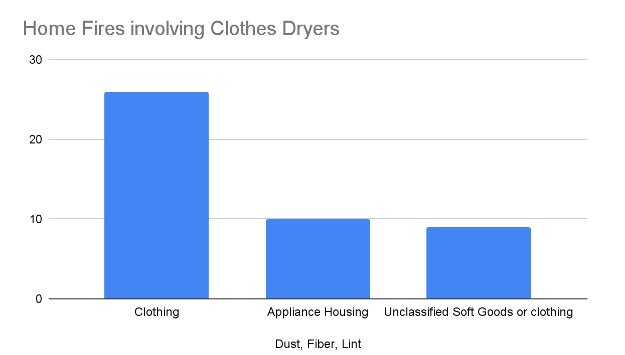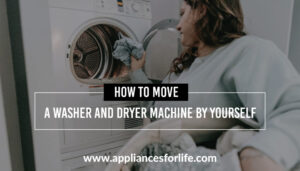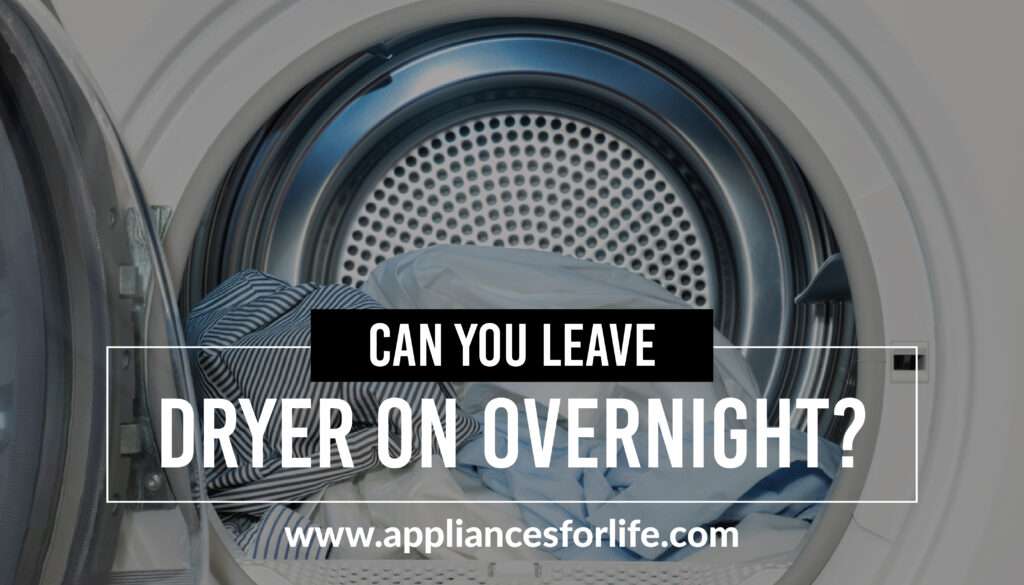- Can you leave your dryer on overnight? Yes and No is the simple, short, and quick answer.
- Leaving your dryer overnight is a convenient way to save time while you sleep.
- Though every household appliance is a fire hazard to a certain extent, dryers have a track record for causing the most blazes.
- Stop the dryer and unplug it from the mains if you notice any of these signs.
This information may be a bitter pill to swallow, but dryer fires are a more common cause of home fires than you admit.
Yes and No is the simple, short, and quick answer. There is more detail to the question; it deserves more than a Yes or No. Let us delve into why running your dryer at night benefits you. We shall also look at the safety risks involved in leaving your dryer running overnight unattended.
Leaving dryer on overnight:
Leaving your dryer overnight is a convenient way to save time while you sleep. In a perfect world, the dryer toils away, and you wake up in the morning to a well-dried bundle of laundry. This overnight work saves time that you can invest in relaxation or work.
There are several reasons why it is not advisable to leave your dryer on overnight.
Noise: If you prefer good old quiet to have a great sleep, your hair dryer at night might make enough noise to deny you that small mercy. Dryers can be significantly loud when running through their cycles, especially if you use a high spin speed.
The noise will not be a big deal if you live in a spacious house with a dedicated laundry room where you can lock the door and close the noise. The noise can keep you awake if you live in a smaller space, though, with the dryer in the kitchen.
Energy and Cost: When you dry your laundry overnight, the dryer will take about an hour or two to complete the cycle. Then it will stay on for the remainder of the night, consuming electricity. Contrast this with when you dry your clothes when you’re around, and you will shut the appliance down as soon as the cycle is complete.
Fire Hazard: Tumble dryers account for more than half of household fires. Clothes dryer fire safety outreach materials.
The standing advice is that you should not leave appliances unattended – avoid turning the tumble dryer on before you leave the house or go to sleep. Tumble dryers will get very hot because they contain powerful motors and fast-moving parts.
Though every household appliance is a fire hazard to a certain extent, dryers have a track record for causing the most blazes. A clogged vent line is the main cause of fire in dryers. The primary job of the vent line is to remove hot air from the drum out the back through a vent. When this line is clogged, it becomes unable to exhaust hot air. The main culprit when it comes to the vent line blockage is lint. The lint filter needs to be regularly cleaned, and when this does not happen, lint builds up and gets trapped in the line. The heat increases during a drying cycle and can trigger a fire.
When clogged vents, ducts, and fluff build-up get exposed to the heating elements of your dryer, they will spark a fire. Your reaction time will be faster and more effective if this happens if you are awake. You will switch off the dryer, attempt to put out the fire, call 911 or do all these. When it catches you asleep, then you are staring at disaster.
Is it safe to leave a dryer on overnight?
This information may be a bitter pill to swallow, but dryer fires are a more common cause of home fires than you admit. The annual statistics from agencies are damning, and dryers cause the lion’s share of these otherwise preventable blazes resulting in hundreds of injuries and millions of dollars in property damage.
Many reasons cause dryer fires, but among the most common causes is failure to perform routine maintenance and keep the appliance clean. Let us take a look at the possible triggers of tumble dryer fires one by one:
Mechanical and Electrical Failure: Faulty wiring and damaged machinery can put you at risk of a dryer fire. It is important to get any worn-out parts checked and replaced. Always make sure not to overload the plug sockets. Nearly all dryer manuals recommend that you give the dryer its wall socket because it is a high-wattage appliance. Make sure to conduct frequent inspections looking out for any scorch marks or exposed electrical wires.
Improper Use: Follow the manual when using your dryer. Many fires are caused by using dryers in total disregard for manufacturer guidelines. These guidelines include over-stuffing the dryer, drying items that should not be put in the dryer, or materials that are fire hazards.
Dirty Lint Filters and Vents: Materials that remain after washing like dirt, grass, and lint can cause a fire. The first catalysts for dryer fires are clogged vents, ducts, and filters. When the lint filter and outside vent become obstructed, airflow is blocked, and the fire risk is magnified. The nests of birds, insects, and rodents can also cause blockage.

NFPA report – Home fires involving clothes dryers and washing machines
Can I leave dryer on overnight?
Whichever way you look, there is a clear risk associated with leaving your dryer on overnight. Now let us take a look at how you can attempt to minimize this risk.
Proper Installation: When you are purchasing your dryer, your vendor will most likely offer you a free home installation to go with it. Make sure you take maximum advantage of this. A dryer not properly installed is an accident waiting to happen, and you do not want to be in the waiting bay with it. You should plug the dryer into an adequate socket, the standard being a 240-volt electrical outlet. Fixing it to a 120-volt outlet is likely to give you problems. The ventilation duct must securely attach to the dryer and the outside exhaust vent. And lastly, select a location for the dryer carefully, ensuring it is clear of other objects, appliances, and items.
Complete Cycle: Make sure every drying program, including the ‘cool down cycle,’ runs to full completion before emptying the machine. Resist the temptation to stop the machine mid-cycle because your laundry will likely still be hot.
Clean the Lint Screen: Tumble dryers need proper airflow to function optimally. Whenever there is a blockage, the heat build-up will follow. A common blockage point is the lint filter. If the lint is not cleaned, a critical mass will accumulate, creating a ready supply of combustible material. It is recommended to clean the lint filter after every drying cycle.
Clean the Vent and Duct: The lint filter doesn’t perfectly collect dirt, loose laundry, and dirt. Some do sneak past the filter into the duct, causing a blockage. Signs of a blocked venting system include:
- Your bundle of laundry takes longer to dry or not completely dry out.
- A burning smell when your tumble dryer is running
- Your clothes are getting too hot
- The outside of your dryer is getting too hot
Stop the dryer and unplug it from the mains if you notice any of these signs. Wait for the duct and vent to cool before checking for any obstructions. It is advisable to remove the duct and clean it at least every three months and, if you can, much more often.
A clogged vent will make the dryer overheat and catch fire, so it should be inspected and cleaned regularly. If your dryer comes with an automatic vent that opens when it is on, always check that it is working properly. If your dryer has no cover, install your own to protect the elements and animals. The dryer duct must vent to the outside, don’t let it vent into the attic or crawl space.
Do not use inside heat recovery diverter valves or terminator boxes as they don’t comply with current standards.
Replace Duct: I want you to remember that not all ducts are created equal. A variety of plastic vents are explosive, which is why many dryers employ a ribbed foil duct, whose foils can trap lint and dust. It is recommended to replace the foil duct with a smooth duct. The ideal for a dryer duct is a solid metallic material as vinyl and foil are flammable. Note that the replacement duct you buy should meet the required standard.
Avoid bending or squeezing the dryer duct during installation in tight spaces, as this will restrict airflow. Consider a dryer box if you want to save space, as it will allow the dryer to be safely installed against the wall.
Make sure to minimize the exhaust duct length; the maximum recommended size is determined by several factors, for example, the dryer model and the number of bends. When all else fails, consider installing a dryer duct booster.
Using a 4-inch-diameter vent pipe and outside exhaust hoods with openings of 16 square inches or more are recommended, offering the least airflow resistance.
Avoid using screws to assemble your vent pipe — the screw shafts inside the tube will collect lint and trigger more friction.
Routine Inspection: Whether using a gas or electric dryer, periodically inspect the lines and the connections and look out for any leaks or poor connections. For maximum safety, let the inspections be conducted by a professional.
Age of your dryer: Old and worn-out parts can cause electrical failure, leading to dryer fires. The average dryer has a lifespan of 10-13 years. Schedule frequent servicing if your dryer is aged. Plan to purchase a new dryer if you realize your technician cannot properly maintain your dryer.
What to do if your dryer catches Fire:
Can anything bad happen if I leave my dryer on overnight? Yes, and fire is at the top of the list regarding bad things that can happen. When your dryer catches fire, it is safe to evacuate everyone to a secure site as the first course of action before calling in the fire department. If you notice the fire early enough, before it becomes a dangerous blaze, an appropriate fire extinguisher can help get it under control.
If you think your dryer is starting a fire, it is advisable not to open its door as it may be too hot for you to handle, and smoke, which may be toxic, may come billowing out. Ensure you have a safe exit and put your family’s safety first.
If you manage to put the fire out, it is important to unplug the dryer from the wall before safely exiting the premises.
Frequently Asked Questions:
Q: Will a tumble dryer shrink clothes?
The heat used to dry clothes, not the tumble dryer, is the culprit. If you are worried about shrinking your clothes, it is safer to under-dry them or hang them up to dry. Under drying means that they should be slightly damp when removed.
Q: Is a 10-year-old tumble dryer too old?
Yes. Your dryer is not too old. Make a point to schedule frequent servicing. If you realize your technician cannot properly maintain your dryer, it’s probably time for a replacement.
Q: Are vented tumble dryers quicker and more efficient than condenser ones?
Vented dryers are usually faster, whereas condenser tumble dryers and heat pump dryers are considerably more energy-efficient. Vent-free dryers are likely to cost much more than dryers with vents. There are trade-offs with each type of dryer.
Conclusion:
In conclusion, taking your clothes dryer for granted is easy even though you use it daily or several times a week. With poor care, dryers can leave your clothes half dry, stop working completely or start a fire. To ensure that your tumble dryer lasts longer, remember to take good care of it, and you can never go wrong with proper maintenance.
22 MINUTES
ESTIMATED TIME DESIGNING AND UPLOADING THIS ARTICLE
10 HOURS 50 MINUTES
ESTIMATED TIME RESEARCHING AND WRITING THIS ARTICLE
You Might Also Like

4 Of The Best Kitchenaid Refrigerators on the Market
Open-box appliances are the best option for you if you are looking for top quality at a relatively cheap rate. No appliance originally is an open-box. It only becomes so after it must have been returned with some blemish found on it. Hence open box

American Made Washing Machines
The United States has played a significant role in the global evolution of household appliances in manufacturing and consumption. This article will be discussing some of the best American-made washing machines. American Made Washing Machines Comparison Table Washing machines are gaining widespread popularity due

How to Lift a Washing Machine (5 Best Tips)
Lifting a washing machine is as easy as a sunday morning. As long as you know what to do. The average washing machine weighs between 150 pounds (68kgs) and 200 pounds (90kgs). The time for moving your washer and dryer has come. Moving a washer

The best cold press juicer is what you’ll need to create healthy options for your snacking needs, and it’s something good to have when you’re on the go. Warm weather is on its way, and you want to be a healthier, better you before it

How To Make Blueberry Juice In A Juicer
As a big fan of juicing, you must have tried several juicing recipes in your juicer. Blueberry juice is one thing people are trying to learn how to make, and our guide for making blueberry juice in a juicer will teach you how to make

How to Clean a Maytag Washing Machine?
Maytag washers have been designed to stand the test of time. They have a sterling reputation for durability among other washing machine brands in the United States. However, just like every other machine, a Maytag washer too can experience necessary wear and tear and if

The Best Crosley 12000 BTU For Your Room
Since their innovation, air conditioners have helped us artificially the temperature of our environment. They become our most valuable asset, especially during summer when the weather is rather hot. Air conditioners serve the desired purpose only when they fit into the space where we want

9 Best Uses Of Baking Soda And Its Health Benefits
Many people wonder if baking soda can be consumed, and the answer is yes, it can be consumed, but only moderately. The U.S. government’s Dietary Guidelines for Americans recommend consuming no more than 2,300 mg of sodium daily. ½ tsp of baking soda will supply

Replacing Your Damaged Haier Refrigerator Door Seal
A refrigerator door seal is oftentimes called refrigerator door gasket. The major function of a refrigerator door gasket is to help it lock appropriately. Without a good gasket, the cold air that preserves your produce will innevitably leak out. On the other hand, the hot

The best juicers on the market are essential appliances for consumers with healthy eating lifestyles! Juicers are a great way to get your recommended servings of fruits and vegetables, especially for those who have a hard time eating their veggies! It is also a great

